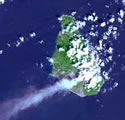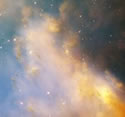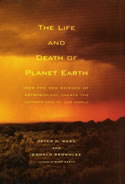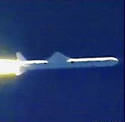
Image credit: NASA
By combining the data from four separate instruments, NASA scientists are able to study the Earth’s volcanoes in tremendous detail. Most recently, Italy’s Mt. Etna was captured mid-eruption using the instruments on board the Terra and Aqua spacecraft, and the data will help the scientists understand the complex behaviour of volcanic plumes and the effects the eruptions have on the environment.
Think of them as the Good Witches of the North, South, East and West, whizzing around the globe daily on their techno “broomsticks” in space. When Europe’s largest, most active volcano, Italy’s Mount Etna, cackled to life and spewed ash and noxious sulfur dioxide gases last October, a quartet of remote sensing instruments from NASA’s Earth Observing System armada flew into action to analyze the smoky, caustic potion.
NASA’s atmospheric science and volcanology wizards can now study the evolution and structure of plumes from Mount Etna and Earth’s 500 or so other active volcanoes in greater detail than ever before. They do this by combining data from the Multi-angle Imaging SpectroRadiometer (Misr), Moderate Resolution Imaging SpectroRadiometer (Modis) and the joint U.S./Japan Advanced Spaceborne Thermal Emission and Reflection Radiometer (Aster) sensors on NASA’s Terra spacecraft with the Atmospheric Infrared Sounder (Airs) and Modis sensors on NASA’s Aqua spacecraft.
“The synergies from NASA’s remote sensing capabilities are helping us understand the complex behavior of volcanic plumes and the effects volcanic eruptions have on the environment,” said Dr. Vince Realmuto, a member of the Earth Observing System volcanology team and supervisor of the Visualization and Scientific Animation Group at NASA’s Jet Propulsion Laboratory, Pasadena, Calif. “By combining data from Airs, Aster, Misr and Modis, we can study volcanic plumes and clouds from many dimensions at once and observe targets of interest like Mount Etna on a daily basis.”
Mount Etna’s most recent eruption, which has subsided but not ended, has released sulfur dioxide into the atmosphere at rates as high as 20,000 metric tons (44.1 million pounds) a day. A major air pollutant vented by some volcanoes, this gas rapidly converts to sulfate aerosols in Earth’s atmosphere, impacting local, regional and global environments.
“At the local and regional level, sulfate aerosols can affect air quality and visibility and cause acid fog and rain, while their small size allows them to penetrate deep into human lungs, impacting respiratory health,” Realmuto said. “To affect global climate, these aerosols have to make their way into Earth’s upper atmosphere, or stratosphere.
“The eruptions of the Philippines’ Mount Pinatubo in 1991 and Mexico’s El Chichon in 1982 deposited aerosols in the stratosphere and had measurable effects on global climate,” Realmuto continued. “These volcanic aerosol layers can reflect incoming solar radiation, resulting in less radiation reaching the ground and throwing off the radiation balance between the Earth, atmosphere and sun. They can trap greenhouse gasses, such as carbon dioxide and water vapor, rising through the atmosphere. They can also lead to the formation of polar stratospheric clouds, a component of the process that destroys Earth’s protective ozone layer.”
Airs, Aster and Modis all collect measurements in the thermal infrared spectrum. Sulfur dioxide, sulfate aerosols and volcanic ash are all easily detectable in this spectral region.
The high spatial resolution of Aster makes it the only orbiting instrument that can detect the non-explosive venting of sulfur dioxide from small volcanic vents. Aster’s visible and near infrared channels can also be used to determine some properties of aerosols and ash. Aster was built by Japan’s Ministry of Economy, Trade and Industry and has a joint U.S./Japan science team.
Airs’ high spectral resolution will allow scientists to identify the components that make up volcanic plumes and estimate the quantity of these components with greater accuracy. In addition, Airs’ atmospheric temperature and relative humidity data will help scientists develop thermal infrared models that can be used to determine ash and aerosol makeup.
Modis’ spatial resolution falls in between that of Aster and Airs. Thus, Modis data are a bridge between the more localized Aster measurements and the more regional Airs data. Since Aster observations of particular targets must be scheduled in advance, Modis often provides the highest spatial resolution thermal infrared data for a given eruption. Both Modis and Airs transmit data in real time-a key to monitoring volcanoes from space.
Misr’s multi-angle imaging allows scientists to identify thin clouds of airborne volcanic ash and aerosol plumes and estimate the abundance and size of the particles. For thicker plumes, Misr can determine the height of the aerosol plume and the speed at which winds are moving the plume through the atmosphere. Knowing the plume height above the ground is important to thermal infrared modeling because it determines the temperature contrast between clouds and their backgrounds. Wind speed data are essential to accurately estimate the rate at which the material is horizontally dispersed into the atmosphere.
Original Source: NASA News Release




